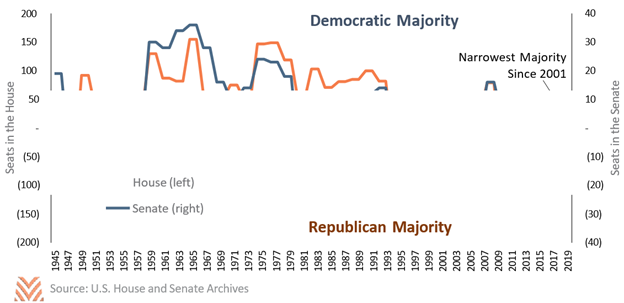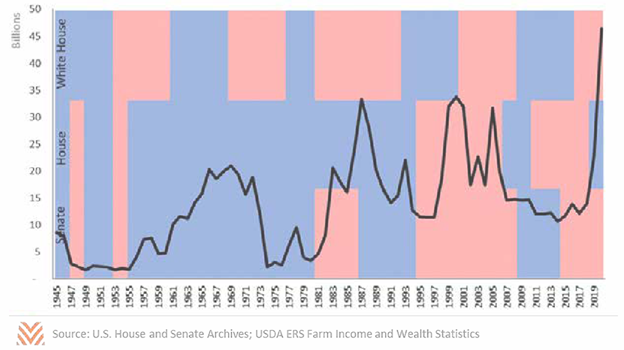Political Landscape

Election Results
The 2020 election cycle was long and contentious, shaped by an economic and health crisis. In addition to the residence at 1600 Pennsylvania Avenue, both major parties sought control of the U.S. House of Representatives and U.S. Senate. With much at stake and partisanship nearing peak levels, the 2020 election rang up as the most expensive in history. At nearly $14 billion in combined campaign funds spent between Congressional races and the presidential race (excluding spending on the two Georgia Senate runoff elections), this year’s election more than doubled spending from the 2016 election cycle. A record number of voters cast mail-in ballots due to concerns about coronavirus spread and overall voter turnout (66.3%) was at the highest level in 120 years. After all states certified their election results, Joe Biden and Kamala Harris won the popular vote and took 306 electoral college votes to win the White House.
There were many interesting threads embedded in the election results. While many swing states swung again in 2020, several did not. The biggest difference-maker for the Biden camp was flipping the “blue wall” states of Pennsylvania, Michigan, and Wisconsin, all of which President Trump carried in 2016. However, other states like Iowa, Ohio, and Florida held a substantial republican vote margin, challenging their actual swing state status. Democratic candidates won in Georgia and Arizona, locking up the states’ electoral votes for the first time in more than 20 years and all four Senate seats. The two Senate seats in Georgia combined with Vice President Harris gave the Democrats control of the Senate, but with no margin for error. Combined with a 11-seat majority in the House, the Democrats face the narrowest majority since 2001, as the figure below shows. This slim margin means President Biden may have to temper some expectations about sweeping policy changes. However, with control of both chambers of Congress, Democrats will have powerful legislative tools like budget reconciliation and the Congressional Review Act to advance legislation and roll back Trump- era regulations.

Appointees and Leadership for Agriculture
With a new president and Congress comes new leadership. President Biden has announced numerous familiar names for his executive cabinet, but three that agricultural producers and lenders should know are Tom Vilsack (Secretary of Agriculture), Katherine Tai (U.S. Trade Representative), and Janet Yellen (Secretary of Treasury). Tom Vilsack needs little introduction, having served as the Secretary of Agriculture for all eight years of the Obama presidency. He brings a deep understanding of agriculture, food programs, and departmental working with him to the cabinet. He has farm bill experience (2014) and was at the department’s helm during the longest ag cycle expansion in history. Katherine Tai is President Biden’s nominee for the U.S. Trade Representative (USTR), a role that has had an increasing impact on the farm, energy, and manufacturing sectors. Tai has rich experience in trade policy serving the USTR as Chief Counsel for China Trade Enforcement in the Obama administration and has been serving as the Chief Trade Counsel for the Democratic Members of the Committee on Ways and Means. Ms. Tai has been critical of China’s trade practices in the past, and she is likely to continue to keep a strong posture with U.S.-China relations leaning more on World Trade Organization systems and regional alliances to influence behavior and outcomes than tariffs alone. Finally, former-Fed Chair Janet Yellen is back as President Biden’s pick for Treasury secretary. Ms. Yellen is a tested economist and central banker who supports expanded economic recovery spending to stimulate the economy in 2021. Combined with a tilt towards continued-low interest rates, her positions could put downward pressure on the relative value of the U.S. dollar in coming years (a net positive for the agricultural sector).
Changes in Congress are also highly impactful for agriculture and rural. The House Agriculture Committee lost its chair with the defeat of Representative Colin Peterson (D-MN). Representative David Scott (D-GA) took the helm in 2021, moving the chair seat from the Midwest to the Southeast. Republicans also have new leadership in the House Ag Committee with Representative Glenn Thompson (R-PA) replacing Mike Conaway (R-TX) after his retirement. Both Peterson and Conaway have been key figures in prior farm bills, so their departure for the House Ag Committee leaves big shoes to fill as we approach the next farm bill in 2023. The Senate Committee on Agriculture chair will be Senator Debbie Stabenow of Michigan, a veteran member of the committee and former chair.
Impacts on Rural and Farm Programs
The new administration is likely to focus on climate and infrastructure, but farm support is unlikely to be forgotten. President Biden’s campaign platform included many calls for investment in energy and manufacturing technology, as well as billions for rural infrastructure such as locks, dams, roads, bridges, and rural broadband. Biofuel and renewable energy incentives were a keystone of the 2009 Recovery Act, and the Biden administration is calling for a renewed focus on these programs in 2021. Conversely, tax policy (particularly estate tax exemption levels and rates), regulation requirements (particularly water and emissions), and farm consolidation are all set to get a fresh look in the coming years. While direct farm payments are not likely to repeat their eye-popping levels from 2020 (over $46 billion and counting) anytime soon, government support for farming operations is not going away. As the figure below shows, regardless of the party in power, direct government support payments rise and fall in all combinations of party control. The best correlation for government payments has been and will continue to be the health of the agricultural economy.











